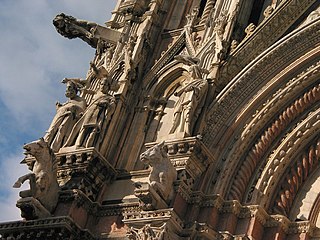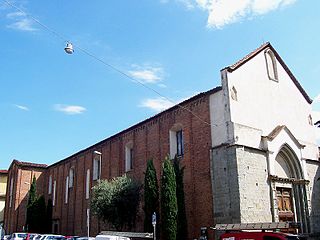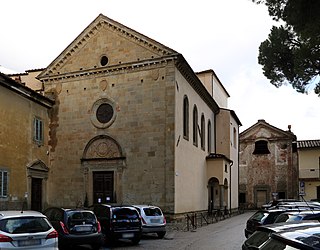
Sebastiano Vini, also known as Bastiano Veronese (Caprino Veronese, 1515 ca. - Pistoia, August 11th, 1602) was an Italian painter of the Renaissance period, active mainly in Tuscany.

Sebastiano Vini, also known as Bastiano Veronese (Caprino Veronese, 1515 ca. - Pistoia, August 11th, 1602) was an Italian painter of the Renaissance period, active mainly in Tuscany.
He was the son of Giovanni Piero. It is unknown under whom or where he trained, but his work shows the influence of Paolo Veronese. By 1548, he had married in Pistoia and remained there most of his life. His son, Jacopo Vini was also a painter.
He was prolific in Pistoia. Among his works was an Annunciation (1552) for the later-suppressed church of San Pierino alla Porta Lucchese, then moved to the Sacristy of the Prepositura del Montale. He painted a Nativity for the main altar of the Conservatory of San Giovanni Battista. He painted for the churches of Letto and of the Monks of San Sebastiano. He painted another Annunciation for the church of San Giovanni Fuoricivitas, and a Presentation at the Temple for the church of the Servites, Santissima Annunziata.
He painted a large fresco (1596?) for the counter-facade of the Oratory of San Desiderio and for the church and cloister of San Domenico. He made few works outside Pistoia, including Cutigliano and Florence. [1]

Tiziano Vecelli or Vecellio, known in English as Titian, was a Venetian painter during the Renaissance, considered the most important member of the 16th-century Venetian school. He was born in Pieve di Cadore, near Belluno. During his lifetime he was often called da Cadore, 'from Cadore', taken from his native region.

Giovanni Battista Tiepolo, also known as GiambattistaTiepolo, was an Italian painter and printmaker from the Republic of Venice who painted in the Rococo style, considered important member of the 18th-century Venetian school. He was prolific, and worked not only in Italy, but also in Germany and Spain.

Paolo Caliari, known as Paolo Veronese, was an Italian Renaissance painter based in Venice, known for extremely large history paintings of religion and mythology, such as The Wedding at Cana (1563) and The Feast in the House of Levi (1573). Included with Titian, a generation older, and Tintoretto, a decade senior, Veronese is one of the "great trio that dominated Venetian painting of the cinquecento" and the Late Renaissance in the 16th century. Known as a supreme colorist, and after an early period with Mannerism, Paolo Veronese developed a naturalist style of painting, influenced by Titian.

Giovanni Pisano was an Italian sculptor, painter and architect, who worked in the cities of Pisa, Siena and Pistoia. He is best known for his sculpture which shows the influence of both the French Gothic and the Ancient Roman art. Henry Moore, referring to his statues for the facade of Siena Cathedral, called him "the first modern sculptor".

The Basilica di Santi Giovanni e Paolo, known in Venetian as San Zanipolo, is a church in the Castello sestiere of Venice, Italy.

Sebastiano Conca was an Italian painter.

Ridolfo di Domenico Bigordi, better known as Ridolfo Ghirlandaio was an Italian Renaissance painter active mainly in Florence. He was the son of Domenico Ghirlandaio.

Sebastiano Ricci was an Italian painter of the late Baroque school of Venice. About the same age as Piazzetta, and an elder contemporary of Tiepolo, he represents a late version of the vigorous and luminous Cortonesque style of grand manner fresco painting.

Giovanni Domenico Ferretti (Giandomenico), also called Giandomenico d'Imola was an Italian Rococo style painter from Florence. According to the contemporary Giovanni Camillo Sagrestani, Ferretti was a pupil of the Bolognese painter Giuseppe Maria Crespi. Others say he worked with painter Giovanni Gioseffo dal Sole.

Anton Domenico Gabbiani was an Italian painter and active in a late Baroque style.

Giacinto Gimignani was an Italian painter, active mainly in Rome, during the Baroque period. He was also an engraver in aquaforte.

Lazzaro Baldi was an Italian painter and engraver of the Baroque period, active mainly in Rome.
Giovanni Luigi Valesio, also known as Giovanni Valesio or Luigi Valesio, was an Italian painter and, most prominently, an engraver of the early-Baroque, active in his native city of Bologna, and then in Rome.

Venetian painting was a major force in Italian Renaissance painting and beyond. Beginning with the work of Giovanni Bellini and his brother Gentile Bellini and their workshops, the major artists of the Venetian school included Giorgione, Titian, Tintoretto (1518–1594), Paolo Veronese (1528–1588) and Jacopo Bassano (1510–1592) and his sons. Considered to give primacy of colour over line, the tradition of the Venetian school contrasted with the Mannerism prevalent in the rest of Italy. The Venetian style exerted great influence upon the subsequent development of Western painting.

The Chiesa di San Sebastiano is a 16th-century Roman Catholic church located in the Dorsoduro sestiere of the Italian city of Venice. The church houses a cycle of paintings by the artist Paolo Veronese, as well as paintings by Tintoretto and Titian. The church is also a member of the Chorus Association of Venetian churches. It stands on the Campo di San Sebastiano by the Rio di San Basilio, close to the Giudecca Canal. It is one of the five votive churches in Venice, each one built after the passing of a plague through the city. Following construction, the church was dedicated to a saint associated with the disease; in this case St. Sebastian.

San Domenico is a Romanesque and Gothic-style, Roman Catholic church located in the Piazza of the same name, with a north flank of the nave parallel to Corso Silvani Fedi, in Pistoia, region of Tuscany, Italy.
Giuseppe Galeòtti (1708-1778) was an Italian painter, active in a Baroque style, mainly in Liguria.

Santa Maria delle Grazie, also known as Madonna del Letto, is a Renaissance-style, Roman Catholic church located near the city center in Pistoia, region of Tuscany, Italy.

The church and convent of the Santissima Annunziata is a Baroque-style, Roman Catholic church located on Piazza de Servi #4, Pistoia, region of Tuscany, Italy. The convent presently functions as a warehouse. The church is down via Laudesi from the San Desiderio, and via Piazza de Servi, From San Giovanni Decollato.
| Wikimedia Commons has media related to Sebastiano Vini . |